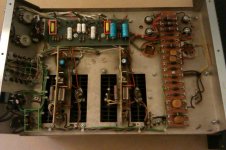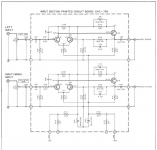This fall I managed to pick up an MC250. Inside it looks like it's all original, so I'm starting a project to replace the electrolytic caps. This is the first time I've worked on this amp, so I thought I might poll the collective wisdom to see if anyone had any insights to share. I'm planning on staying within the specs (no big upgrades) as far as I can with modern parts.
1) I'm replacing every electrolytic *except* the big power supply caps. I've read that these rarely need replacing, so I'm counting on them begin good for a while yet. Is that foolish?
2) Along with the electrolytics there are a couple of Mylar caps on the input board that I've seen others replacing as well. (I've highlighted them in red on the image). Generally they've been replaced with electrolytics. Is this a good idea? Or should I try to stick with Mylar? They're C47 & 48 in the schematic (in the linked service manual).
3) At the same time I'm planning on replacing the two-prong power cord with a three-prong. It looks like there's an unused ground hook on the terminal strip that I was planning on tying into. Will this give me any hum or grounding grief?
Service Manual
If you've done a similar upgrade, I'd be interested in hearing any and all experiences too.
Thanks!
1) I'm replacing every electrolytic *except* the big power supply caps. I've read that these rarely need replacing, so I'm counting on them begin good for a while yet. Is that foolish?
2) Along with the electrolytics there are a couple of Mylar caps on the input board that I've seen others replacing as well. (I've highlighted them in red on the image). Generally they've been replaced with electrolytics. Is this a good idea? Or should I try to stick with Mylar? They're C47 & 48 in the schematic (in the linked service manual).
3) At the same time I'm planning on replacing the two-prong power cord with a three-prong. It looks like there's an unused ground hook on the terminal strip that I was planning on tying into. Will this give me any hum or grounding grief?
Service Manual
If you've done a similar upgrade, I'd be interested in hearing any and all experiences too.
Thanks!
Attachments
So, after a bit more reading I've decided *not* to replace the power cord since it may result in a ground loop (the attached computer is already grounded). The folks over in the Grateful Dead forums (apparently Jerry Garcia loved the MC250!) have largely agreed on this point.
I've also put together my DigiKey order for replacement caps. Here's what I have:
C11, C12
Was: 470µF, 4V
Replacing with: Vishay 470µF 6.3V MAL202133471E3
C51, C52
Was: 100µF, 15V
Replacing with: Nichicon 100µF 25V UKZ1E101MPM
C53, C54
Was: 10µF 25V
Replacing with: Nichicon 10µF 25V UES1E100MDM1TD (Bi-Polar)
C55, C56
Was: 640µF, 25V
Replacing with: Nichicon 1000µF, 25V TVX1E102MCD (Axial)
OR: Nichicon 680µF, 35V UKL1V681MHD1TN
The only one I'm not completely convinced by is the C55, C56 replacement. I'm not sure what will be the effect of upping the capacitance to 1000µF. However, this is the only real choice if I wanted to go with axial. The other possibility is to go closer to the capacitance in a Radial. The "KL" series is also supposed to be low-leakage current.
I've also put together my DigiKey order for replacement caps. Here's what I have:
C11, C12
Was: 470µF, 4V
Replacing with: Vishay 470µF 6.3V MAL202133471E3
C51, C52
Was: 100µF, 15V
Replacing with: Nichicon 100µF 25V UKZ1E101MPM
C53, C54
Was: 10µF 25V
Replacing with: Nichicon 10µF 25V UES1E100MDM1TD (Bi-Polar)
C55, C56
Was: 640µF, 25V
Replacing with: Nichicon 1000µF, 25V TVX1E102MCD (Axial)
OR: Nichicon 680µF, 35V UKL1V681MHD1TN
The only one I'm not completely convinced by is the C55, C56 replacement. I'm not sure what will be the effect of upping the capacitance to 1000µF. However, this is the only real choice if I wanted to go with axial. The other possibility is to go closer to the capacitance in a Radial. The "KL" series is also supposed to be low-leakage current.
Thanks ishuru,
I've attached the input section schematic. The bold lines are the signal path. C55/56 are in the bottom centre. I'm not sure of their exact purpose (just learning about this stuff, which is why I'm asking questions!) but it doesn't look like they're in the signal path.
I've attached the input section schematic. The bold lines are the signal path. C55/56 are in the bottom centre. I'm not sure of their exact purpose (just learning about this stuff, which is why I'm asking questions!) but it doesn't look like they're in the signal path.
Attachments
Thanks ishuru,
I've attached the input section schematic. The bold lines are the signal path. C55/56 are in the bottom centre. I'm not sure of their exact purpose (just learning about this stuff, which is why I'm asking questions!) but it doesn't look like they're in the signal path.
it's supply section..it's safe to use a bigger caps 🙂
Thanks again ishiru.
I think I've also decided to leave the mylar caps in place, since they don't seem to be a common point of failure. I'm more interested in making this thing safe and reliable than "upgrading" it.
I think I've also decided to leave the mylar caps in place, since they don't seem to be a common point of failure. I'm more interested in making this thing safe and reliable than "upgrading" it.
With those that you listed in the earlier post?
Anything else you did while you were in there?
I"m going down that road going to be fixin' it.
First I have to figure out what is wrong.
If I read every one right, I should replace
the electrolytic first, then bring it up slowly
and check the transistors. I do have
three pieces that have the same channel
fried on them.
Cheers,
Anything else you did while you were in there?
I"m going down that road going to be fixin' it.
First I have to figure out what is wrong.
If I read every one right, I should replace
the electrolytic first, then bring it up slowly
and check the transistors. I do have
three pieces that have the same channel
fried on them.
Cheers,
No, I didn't want to touch too much, so I just replaced the caps. Here's the digikey parts numbers I used:
4000PHCT-ND
CAP ALUM 470UF 6.3V 20% AXIAL
CUST REF #: C11, C12
493-3190-ND
CAP ALUM 100UF 25V 20% RADIAL
CUST REF #: C51, C52
493-10824-1-ND
CAP ALUM 10UF 25V 20% RADIAL
CUST REF #: C53, C54
493-13368-ND
CAP ALUM 1000UF 25V 20% AXIAL
CUST REF #: C55, C56
4000PHCT-ND
CAP ALUM 470UF 6.3V 20% AXIAL
CUST REF #: C11, C12
493-3190-ND
CAP ALUM 100UF 25V 20% RADIAL
CUST REF #: C51, C52
493-10824-1-ND
CAP ALUM 10UF 25V 20% RADIAL
CUST REF #: C53, C54
493-13368-ND
CAP ALUM 1000UF 25V 20% AXIAL
CUST REF #: C55, C56
Thank you.
Do you mind if I post that over in a wiki?
It should be easier to find and we can always
make changes later on, while in posts they are
kind of cast in stone.
What was the affect of the changes that you made?
How was your amp doing before and now after?
Cheers
Do you mind if I post that over in a wiki?
It should be easier to find and we can always
make changes later on, while in posts they are
kind of cast in stone.
What was the affect of the changes that you made?
How was your amp doing before and now after?
Cheers
Yeah, go ahead! Maybe you can post a link back in this thread when you put it on the wiki?
As far as I can tell there were no changes to the sound of the amp. It was doing just fine before (as far as I could tell), so this was just a precautionary change.
As far as I can tell there were no changes to the sound of the amp. It was doing just fine before (as far as I could tell), so this was just a precautionary change.
- Status
- Not open for further replies.
- Home
- Amplifiers
- Solid State
- McIntosh MC250 Capacitor replacement

